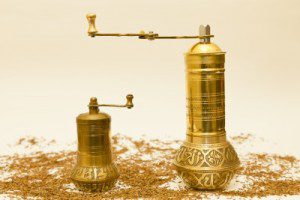By Sayer Ji
Contributing writer for Wake Up World
Traded along spice routes separating ancient cultures by vast distances, spices like cumin were once worth their weight in gold. Has modern science now revealed why, beyond their remarkable aesthetic value, they were so highly prized?
Many spices are perfectly happy living a charmed life as seasonings, peppering things generously with flavor, and without ever arousing the suspicion that they may be capable of profound acts of healing, as well.
Meet cumin, a member of the parsley family, which is to say from a well-known family of healers native to the central Mediterranean region (southern Italy, Algeria and Tunisia).
Cumin’s traditional use stretches back into prehistory, as evidenced by its presence in Egyptian tombs. The Greeks actually used it much like we use pepper today, keeping cumin at the dining table in its own container, which is still practiced by Moroccans to this day. It is also been used for millennia in India as a traditional ingredient of curry.
New research now indicates that these ancient “culinary” uses, once considered primarily aesthetic in nature, may have served more fundamental medicinal roles in these cultures. How do we know this? Modern scientific investigation has revealed that cumin has a broad range of potential healing properties that, when properly applied, could alleviate human suffering.
For instance, as recently as 2010, research published in the journal Food Chemistry and Toxicologydemonstrated that cumin has blood sugar lowering properties comparable to the drug glibenclamide (known in the US as glyburide), with the additional benefit (not conferred by pharmaceutical intervention) that it also lowered oxidative stress and inhibited the advanced glycated end products (AGE) which are implicated in the pathogenesis of diabetic microvascular complications.[i]
Remarkably, this is only the tip of cumin’s medicinal potential. There are at least 10 other potential medicinal properties of cumin now confirmed in the experimental literature:
- Bacterial Infections: Cumin oil has been shown effective at killing Klebsiella penumoniae bacteria, including decreasing biofilm formation (a defense mechanism of bacteria against antibiotics), as well as enhancing the antimicrobial activity of conventional antibiotic drugs like ciprofloxacin.[ii] Even more impressive, perhaps, cumin oil has been shown to have anti-MRSA properties.[iii]
- Candida (Yeast) Infection: Unlike conventional antibiotics which contribute to opportunistic fungal overgrowth, cumin has been shown to have considerable inhibitory activity against 3 different Candida albicans strains of yeast.[iv] It has also been studied to be effective against a wide range of other fungi and yeasts, including Aspergilli and dermatophytes (fungi that cause skin diseases).[v]
- Cataracts: Cumin has been shown to delay the formation of diabetes-associated cataracts primarily through its anti-glycating properties, i.e. it prevents elevated blood sugar from getting “sticky” (i.e. caramelization) and subsequently damaging tissues in the body.[vi]
- Cancers: Cumin has been shown in preclinical research to have inhibitory activity against cervical cancer[vii] and colon cancer. [viii]
- Dental Plaque: Cumin oil has been shown effective as an anti-gingival agent alternative to the chemical chlorhexidine commonly used in mouthwashes.[ix]
- Diabetes: As mentioned in our opening, cumin has significant anti-diabetic properties. Another 2002 study found that the treatment of diabetic rats with cumin was more effective than the drug glibenclamide, resulting in reductions in inflammation, fatty changes, tissue cholesterol, triglycerides, free fatty acids, blood glucose and glycated hemoglobin – all positive indicators. [x]
- Food-borne Pathogens – Cumin oil has been found to work synergistically with other food preservation agents to inhibit the growth of food-borne pathogens.[xi]
- Immune Function: Cumin has been found to effectively stimulate immune function in a way that may benefit immune-compromised individuals.[xii]
- Fertility (Reversible Contraceptive): Cumin has been found to have potent contraceptive activities in male rats without apparent toxicity.[xiii]
- Memory Disorders: Cumin has been found to reduce stress-induced oxidative changes in the brain, as well as improving cognition, as determined by acquisition, retention and recovery in rats, in a dose-dependent manner.[xiv]
- Morphine Dependence/Tolerance: Cumin reduces morphine tolerance and dependence. [xv][xvi]
- Osteoporosis: Cumin extract has been shown effective at reversing bone loss associated with the loss of ovarian function at least as well as estradiol.[xvii]
- Thrombosis (Clot): Cumin seed has been demonstrated to inhibit platelet aggregation, indicating it may prevent pathological blood clotting.[xviii] [Note: of course this means that it could interact adversely with blood thinners].
The evidence-based approach to understanding cumin’s medicinal value is relatively new. Only in the past two decades, but especially in the past five years, scientific research on spices and culinary herbs has virtually exploded. While enlightening, we must remember that the approach is limited in a number of ways. For one, it relies on animal research, which is both inherently cruel (vivisection) and conveys only approximate data, as these substances often have very different effects in animals than humans.
Also, spices like cumin should not be considered in isolation, as traditional recipes passed down from generation to generation contained a vast storehouse of medically relevant information pertaining to the synergies inherent in combinations of ingredients, modes of preparation, seasonal harvesting, etc. In other words, cumin does not lend itself well to the pharmacological, drug-based model of medicine, which presumes there are monochemical “magic bullets” within complex herbs or spices that must be identified and isolated into megadoses, and which are primarily responsible for their beneficial effects.
Nonetheless, it is welcoming that increasingly science confirms traditional herbalism and culinary practice. Perhaps, as the scientific evidence continues to pour in, we will be more willing to give ourselves permission to appreciate once again the wondrous superfluity of nature, its ceaseless benevolence, and the the fact that issuing directly from her fecund soil, are powerful healing gifts, that we can enjoy sensually, viscerally and now intellectually with greater abandon.
Article Sources
- [i] A G Jagtap, P B Patil. Antihyperglycemic activity and inhibition of advanced glycation end product formation by Cuminum cyminum in streptozotocin induced diabetic rats. Food Chem Toxicol. 2010 Aug-Sep;48(8-9):2030-6. Epub 2010 May 6. PMID: 20451573
- [ii] Safoura Derakhshan, Morteza Sattari, Mohsen Bigdeli. Effect of cumin (Cuminum cyminum) seed essential oil on biofilm formation and plasmid Integrity of Klebsiella pneumoniae. Pharmacogn Mag. 2010 Jan ;6(21):57-61. Epub 2010 Feb 13. PMID: 20548937
- [iii] Shayamapda Mandal, , Krishnendu Saha, Nishith Kumar Pal. In Vitro Antibacterial Activity of three Indian Spices Against Methicillin-Resistant Staphylococcus aureus. Oman Med J. 2011 Sep ;26(5):319-23. PMID: 22125725
- [iv] Juergen Wanner, Stefanie Bail, Leopold Jirovetz, Gerhard Buchbauer, Erich Schmidt, Velizar Gochev, Tanya Girova, Teodora Atanasova, Albena Stoyanova. Chemical composition and antimicrobial activity of cumin oil (Cuminum cyminum, Apiaceae). Nat Prod Commun. 2010 Sep ;5(9):1355-8. PMID: 20922990
- [v] Carlo Romagnoli, Elisa Andreotti, Silvia Maietti, Rai Mahendra, Donatella Mares. Antifungal activity of essential oil from fruits of Indian Cuminum cyminum. Pharm Biol. 2010 Jul ;48(7):834-8. PMID: 20645785
- [vi] Pasupulati Anil Kumar, Paduru Yadagiri Reddy, P N B S Srinivas, Geereddy Bhanuprakash Reddy. Delay of diabetic cataract in rats by the antiglycating potential of cumin through modulation of alpha-crystallin chaperone activity. J Nutr Biochem. 2008 Sep 10. PMID: 18789666
- [vii] Gagandeep, Sivanandhan Dhanalakshmi, Ester Méndiz, Agra Ramesha Rao, Raosaheb Kathalupant Kale. Chemopreventive effects of Cuminum cyminum in chemically induced forestomach and uterine cervix tumors in murine model systems. Nutr Cancer. 2003;47(2):171-80. PMID: 15087270
- [viii] N Nalini, V Manju, V P Menon. Effect of spices on lipid metabolism in 1,2-dimethylhydrazine-induced rat colon carcinogenesis. J Med Food. 2006;9(2):237-45. PMID: 16822210
- [ix] Shojaedin Shayegh, Iraj Rasooli, Massoud Taghizadeh, Shakiba Darvish Alipoor Astaneh. Phytotherapeutic inhibition of supragingival dental plaque. Nat Prod Res. 2008 Mar 20;22(5):428-39. PMID: 18404563
- [x] Surya Dhandapani, Vijayakumar Ramasamy Subramanian, Senthilkumar Rajagopal, Nalini Namasivayam. Hypolipidemic effect of Cuminum cyminum L. on alloxan-induced diabetic rats. Pharmacol Res. 2002 Sep;46(3):251-5. PMID: 12220968
- [xi] M R Pajohi, H Tajik, A A Farshid, M Hadian. Synergistic antibacterial activity of the essential oil of Cuminum cyminum L. seed and nisin in a food model. J Appl Microbiol. 2011 Jan 12. Epub 2011 Jan 12. PMID: 21226797
- [xii] Prashant Singh Chauhan, Naresh Kumar Satti, Krishan Avtar Suri, Musarat Amina, Sarang Bani. Stimulatory effects of Cuminum cyminum and flavonoid glycoside on Cyclosporine-A and restraint stress induced immune-suppression in Swiss albino mice. Chem Biol Interact. 2010 Feb 12. Epub 2010 Feb 12. PMID: 20156427
- [xiii] Radhey S Gupta, Poonam Saxena, Rajnish Gupta, Jai B S Kachhawa. Evaluation of reversible contraceptive activities of Cuminum cyminum in male albino rats. Contraception. 2011 Jul ;84(1):98-107. Epub 2011 Feb 16. PMID: 21664518
- [xiv] Magda Katsiki, Niki Chondrogianni, Ioanna Chinou, A Jennifer Rivett, Efstathios S Gonos. Cuminum cyminum extract attenuates scopolamine-induced memory loss and stress-induced urinary biochemical changes in rats: a noninvasive biochemical approach. Pharm Biol. 2011 Jul ;49(7):702-8. PMID: 21639683
- [xv] Abbas Haghparast, Jamal Shams, Ali Khatibi, Amir-Mohammad Alizadeh, Mohammad Kamalinejad. Effects of the fruit essential oil of Cuminum cyminum Linn. (Apiaceae) on acquisition and expression of morphine tolerance and dependence in mice. Neurosci Lett. 2008 Aug 1;440(2):134-9. Epub 2008 May 22. PMID: 18550281
- [xvi] Ali Khatibi, Abbas Haghparast, Jamal Shams, Elham Dianati, Alireza Komaki, Mohammad Kamalinejad. Effects of the fruit essential oil of Cuminum cyminum L. on the acquisition and expression of morphine-induced conditioned place preference in mice. Wound Repair Regen. 1999 Sep-Oct;7(5):362-74. PMID: 18950682
- [xvii] Sarika S Shirke, Sanket R Jadhav, Aarti G Jagtap . Methanolic extract of Cuminum cyminum inhibits ovariectomy-induced bone loss in rats. Exp Biol Med (Maywood). 2008 Sep 29. PMID: 18824723
- [xviii] K C Srivastava. Extracts from two frequently consumed spices–cumin (Cuminum cyminum) and turmeric (Curcuma longa)–inhibit platelet aggregation and alter eicosanoid biosynthesis in human blood platelets. Phytother Res. 2004 Aug;18(8):670-3. PMID: 2503839
Recent articles by Sayer Ji
- The Evidence-Based Healing Properties of 13 Common Fruits
- Dental Composites for Kids: Even Worse Than Mercury Amalgam?
- 13 Evidence-Based Medicinal Properties of Coconut Oil
- Five Amazing Healing Honey Facts
- Is This Fruit Extract 10,000 Times Better Than Chemotherapy?
About the author
 Sayer Ji is the founder and director of GreenMedInfo.com and an advisory board member at the National Health Federation, an international nonprofit, consumer-education, health-freedom organization. He co-authored the book Cancer Killers: The Cause Is The Cure, and is working on another one with Tania Melkonian titled EATomology: An Edible Philosophy of Food.
Sayer Ji is the founder and director of GreenMedInfo.com and an advisory board member at the National Health Federation, an international nonprofit, consumer-education, health-freedom organization. He co-authored the book Cancer Killers: The Cause Is The Cure, and is working on another one with Tania Melkonian titled EATomology: An Edible Philosophy of Food.

If you've ever found value in our articles, we'd greatly appreciate your support by purchasing Mindful Meditation Techniques for Kids - A Practical Guide for Adults to Empower Kids with the Gift of Inner Peace and Resilience for Life.
In the spirit of mindfulness, we encourage you to choose the paperback version. Delve into its pages away from screen glare and notifications, allowing yourself to fully immerse in the transformative practices within. The physical book enriches the learning process and serves as a tangible commitment to mindfulness, easily shared among family and friends.
Over the past few years, Wake Up World has faced significant online censorship, impacting our financial ability to stay online. Instead of soliciting donations, we're exploring win-win solutions with our readers to remain financially viable. Moving into book publishing, we hope to secure ongoing funds to continue our mission. With over 8,500 articles published in the past 13 years, we are committed to keeping our content free and accessible to everyone, without resorting to a paywall.
Disclaimer: This article is not intended to provide medical advice, diagnosis or treatment. Views expressed here do not necessarily reflect those of Wake Up World or its staff.







